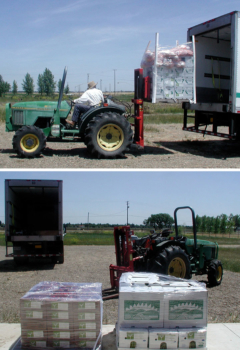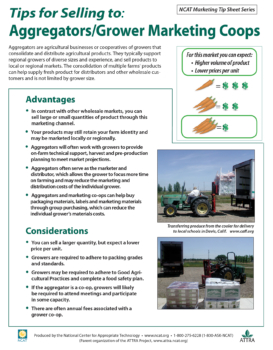Tips for Selling to Aggregators/Grower Marketing Coops
NCAT Marketing Tipsheet Series
By Marisa Alcorta, Rex Dufour, and Tammy Hinman, NCAT

Transferring produce from the cooler for delivery to local schools in Davis, CA. Photo: caff.org
Aggregators are agricultural businesses or cooperatives of growers that consolidate and distribute agricultural products. They typically support regional growers of diverse sizes and experience, and sell products to local or regional markets. The consolidation of multiple farms’ products can help supply fresh product for distributors and other wholesale customers and is not limited by grower size.
For this market you can expect:
- Higher volume of product
- Lower prices per unit
Advantages
- In contrast with other wholesale markets, you can sell large or small quantities of product through this marketing channel.
- Your products may still retain your farm identity and may be marketed locally or regionally.
- Aggregators will often work with growers to provide on-farm technical support, harvest and pre-production planning to meet market projections.
- Aggregators often serve as the marketer and distributor, which allows the grower to focus more time on farming and may reduce the marketing and distribution costs of the individual grower.
- Aggregators and marketing co-ops can help buy packaging materials, labels and marketing materials through group purchasing, which can reduce the individual grower’s materials costs.
Considerations
- You can sell a larger quantity, but expect a lower price per unit.
- Growers are required to adhere to packing grades and standards.
- Growers may be required to adhere to Good Agricultural Practices and complete a food safety plan.
- If the aggregator is a co-op, growers will likely be required to attend meetings and participate in some capacity.
- There are often annual fees associated with a grower co-op.
Tips for Selling to Aggregators/Grower Marketing Coops
If you are starting a cooperative aggregation group, be sure you understand how the legal business structure of a cooperative works. Contact the USDA Rural Business Cooperative Service to help guide you through the process and possibly access federal funding.
- Aggregation on a local level is a fairly new concept. Look for grower recruitment meetings, or ask around to find out if one is located near you.
- BEFORE you begin production, call the aggregators to find out what products they are looking for.
Key Questions to Ask Yourself
- How will my membership with the aggregator or growers co-op align with my personal and business goals?
- Has this aggregator or co-op been successful or in business for more than a short period of time? Do they have a good reputation?
- If it’s a co-op, what kind of time commitment is required? Am I willing to work with a group to help market our collective produce?
- Am I prepared to adhere to quality and other standards that are set by the group?
Resources
The Packer is a weekly newspaper covering fruit and vegetable news, produce shipping, distribution, packing, marketing, and trends in fresh produce in North America.
Rocky Mountain Farmers Union provides training and assistance to farmers who want to organize marketing cooperatives in New Mexico, Colorado, and Wyoming.
Scaling Up: Meeting the Demand For Local Food compares 11 aggregator models from across the country.
U.S. Agricultural Marketing Service (AMS) Fresh Fruit, Vegetable, Nut, and Specialty Crop Grade Standards lists the quality standards for fruits, vegetables and nuts sold as commodities.
USDA Rural Development, Business and Cooperative Programs offer many publications about cooperatives as well as the bi-monthly Rural Cooperatives magazine.
Wholesale Success: A Farmers Guide to Selling, Post Harvest Handling, and Packing Produce is a 255-page manual about the wholesale produce industry, with details on building relationships, food safety, grading standards, filling orders, record keeping, and billing. The manual includes harvesting, cooling, storing, and packing information for 103 different fruits and vegetables.
Tips for Selling to Aggregators/Grower Marketing Coops
© 2012 National Center for Appropriate Technology—NCAT
By Marisa Alcorta, Rex Dufour, and Tammy Hinman, NCAT
IP434
This publication is produced by the National Center for Appropriate Technology through the ATTRA Sustainable Agriculture program, under a cooperative agreement with USDA Rural Development. This publication was also made possible in part by funding from USDA/NIFA/OASDFR. ATTRA.NCAT.ORG.
Related Publications
- Illustrated Guide to Growing Safe Produce on Your Farm: Good Agricultural Practices
- Tips for Selling at Roadside Stands
- Tips for Selling to Institutional Markets
- Tips for Selling to Wholesale Buyers at Terminal Markets
- Tips for Selling to Produce Distributors
- Tips for Selling to Produce Packing Houses
- Tips for Selling with Agritourism and “Pick-Your-Own”


